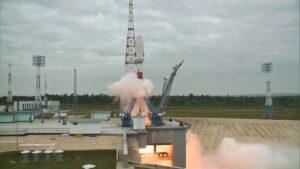What was reported as a race with India to achieve a soft landing on the moon at the southern pole ended for Russia as its Luna-25 moon lander crashed on the lunar surface. The launch of the powerful Soyus-2.1b Fregat rocket carrying the Luna-25 lifted off from the Vostochny Cosmodrome in Siberia on August 11, with Russian space agency Roscosmos hopeful of a triumphant return to the moon. Alas, eight days into the mission, those hopes were dashed when the lander failed to respond to communications signals during its pre-landing phase, and the unmanned spacecraft impacted the surface in an uncontrolled condition.
Luna-25 Failed as the First Soft Landing at the Moon’s South Pole.
The day before the Roscosmos lunar expedition liftoff, Liberty Nation explained:
“The Luna-25 weighs approximately 3,850 pounds fully fueled and with scientific equipment and solar panels onboard… The landing site for the craft is at the southern pole of the moon, where it will carry out experiments to analyze the composition of the polar regolith (dust and other matter covering rocks) and determine if ice or valuable minerals might be present.”
Luna-25 was to be the first soft landing on the moon’s South Pole. However, the anticipated year-long lunar-surface exploration was cut short before it began. “The Luna-25 automatic lunar station, according to unconfirmed data, has been destroyed after colliding with the Moon’s surface,” the Russian News Agency TASS told reporters. “At about 2:57 p.m. Decree time (11:57 a.m. GMT), the connection with the Luna-25 automatic lunar probe was lost.” Continued attempts to reestablish communications on August 19 and 20 were unsuccessful. Early reports of the failure of the Luna-25 mission did not provide any information on where on the moon’s surface the Russian spacecraft impacted. Landing in the lunar South Pole region is difficult. Luna-25’s preferred landing zone was Boguslawsky Crater; however, finding the crash site may be difficult since the problems occurred during the orbit-to-landing transition.
The Russian lunar lander was in its low orbit phase, of the soft-landing profile, “The pilotless spacecraft was aiming to be the first ever to land on the south pole of the Moon, an area where scientists believe there could be important reserves of frozen water and precious elements. It had been expected to land Monday,” Associated Press wrote in a dispatch from Moscow. The importance of the Luna-25 mission for preserving the Russian image cannot be overstated. Russian President Vladimir Putin touted the resilience of Moscow’s capability to continue its space program even in the face of sanctions by the West for Putin’s unprovoked invasion of Ukraine.
Invasion of Ukraine May Have Impacted Luna-25 Mission
“Political and aerospace experts in the West speculated that the international sanctions on Russia following its invasion of Ukraine might have cut off its space program from access to key technologies,” Bojan Pancevski wrote in The Wall Street Journal. “A successful operation could have shown that the Kremlin still has technological prowess.” But it wasn’t successful. Where does that leave the Kremlin now? If the Russian space agency intended to demonstrate its capability to compete and be successful in a race to the moon, as Putin indicated, the Luna-25 crash is a severe setback.

(Photo by Xinhua via Getty Images)
“Russia was racing to the Moon’s south pole against India, whose Chandrayaan-3 spacecraft is scheduled to land there in the coming days and send a rover to explore the rocks and craters, gathering data and images to send back to Earth,” the BBC reported. However, the mission profiles of the two spacecraft were decidedly different. The Luna-25 mission objective was to take a direct route to the moon. On the other hand, a Liberty Nation report described the Indian Chandrayaan-3 lunar journey as having a longer pre-landing mission involving “numerous maneuvers and lunar orbit insertions as positioning experiments.” The Indian methodology seemed more deliberate and structured with a crawl, walk, run approach.
If, in its haste to be the first country to make a soft landing on the moon’s south pole beat India, Roscosmos took technological shortcuts, that would be unfortunate. Yet Russia’s attack on Ukraine was impulsive and has proven disastrous. The failure of Luna-25 has seriously bruised Putin’s driving motivation to be a relevant global power. The recent successful US Artemis 1 mission, combined with the Indian Chandrayaan-3 spacecraft performing as designed, makes Russia appear an also-ran in the space race.

